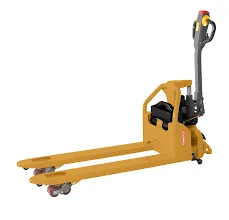


Understanding the Long Fork Pallet Jack A Comprehensive Guide
In the realm of warehouse operations and material handling, efficiency and precision are paramount. One of the essential tools that facilitate streamlined movement of goods is the pallet jack, particularly the long fork pallet jack. This versatile piece of equipment can significantly enhance productivity in a variety of settings, from bustling distribution centers to smaller retail environments. In this article, we will delve into the features, benefits, and applications of long fork pallet jacks to understand their importance in modern logistics.
What is a Long Fork Pallet Jack?
A long fork pallet jack is essentially a hand-operated or electric device designed for lifting and moving palletized loads. The distinguishing feature of the long fork model is its extended forks, which allow it to accommodate larger and heavier loads compared to standard pallet jacks. Typically, the forks of a standard pallet jack measure around 48 inches, whereas long fork pallet jacks can extend up to 72 inches or more. This design is specifically useful for handling oversized pallets or loads, making it an invaluable asset in various industries.
Key Features
1. Extended Fork Length The most notable feature is the longer fork length that enables the lifting of larger pallets. This not only improves functionality but also reduces the number of trips required to move goods, thus saving time and labor.
2. Load Capacity Long fork pallet jacks are engineered to support heavier weights, often boasting load capacities ranging from 2,500 to 5,500 pounds. This makes them suitable for a wide array of materials, from bulky industrial items to standard pallets.
3. Ergonomic Design Many long fork pallet jacks come equipped with ergonomic handles that facilitate ease of use, reducing strain on the operator. This is particularly important in environments where staff may be operating the jack for extended periods.
4. Mobility and Maneuverability Equipped with durable wheels, long fork pallet jacks offer smooth maneuverability across different surfaces, whether it be in a warehouse or on a shipping dock. Some models even feature swivel casters for enhanced control.
5. Hydraulic Lift System The hydraulic system enables operators to lift and lower loads with minimal effort. This feature enhances safety and efficiency, allowing for swift handling of goods.

Benefits of Using Long Fork Pallet Jacks
1. Increased Efficiency By incorporating long fork pallet jacks into operations, businesses can maximize throughput. The ability to move larger loads in a single trip helps reduce the time spent on logistics.
2. Versatility These pallet jacks can handle various sizes and types of pallets, making them ideal for industries that deal with a diverse range of products.
3. Cost-Effective Utilizing a long fork pallet jack can decrease the need for additional equipment, such as forklifts, especially in smaller spaces where maneuverability is limited.
4. Enhanced Safety With their sturdy construction and advanced hydraulic systems, long fork pallet jacks minimize the risks associated with manually lifting heavy loads. Proper use reduces the chances of accidents and injuries in the workplace.
Applications
Long fork pallet jacks are instrumental across multiple sectors, including
- Retail For moving large shipments received at distribution centers. - Manufacturing To transfer raw materials or finished goods around the production area. - Food and Beverage Used to handle pallets of inventory, ensuring efficient stock management. - Construction Ideal for moving heavy building materials such as bricks and lumber.
Conclusion
The long fork pallet jack stands as a testament to the importance of effective material handling solutions in today’s fast-paced industrial landscape. Its extended reach, robust construction, and ergonomic design collectively make it an indispensable tool across various sectors. As businesses look to enhance their logistical operations, investing in a long fork pallet jack not only fulfills immediate material handling needs but also contributes to long-term efficiency and cost savings. Embracing such technology is crucial for any organization aiming to remain competitive in an increasingly demanding marketplace.



